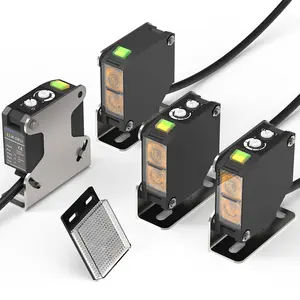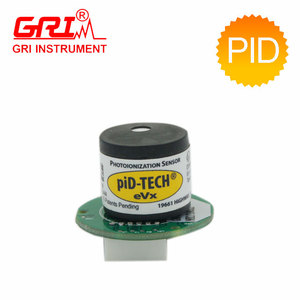الرائج في مجال عملك






وحدة الزراعة الذكية هي مستشعر شامل عالي الأداء لرصد البيئة واحتساب البيانات
٥٦٥٫١٠ ر.س. - ١٬٢٤٠٫٩٢ ر.س.
لمين: 1 قطعة







GTRIC تحقيقات جهاز استشعار ضوئي ألياف محوري منتشر انعكاس اقتصادية الألياف البصرية مكبر للصوت الاستشعار
٦٫٨٨ ر.س. - ١٠٫٧٠ ر.س.
لمين: 2 قطعة







جهاز استشعار القرب الكهروضوئي GTRIC E3JK 24VDC مرحل خرج ضوء الانتشار بالأشعة تحت الحمراء مربع بصري كهروضوئي
٢٤٫٨٢ ر.س. - ٥٣٫٤٦ ر.س.
لمين: 2 قطعة













جهاز استشعار VOC PID, جهاز استشعار اتصالات RS485 0-10000PPM
جاهز للشحن
٣٬١٨٨٫٢١ ر.س. - ٣٬٢٢٦٫٣٩ ر.س.
لمين: 1 قطعة
الشحن لكل قطعة: ٩٦٫٨٧ ر.س.

عالية الدقة PID المركبات العضوية المتطايرة VOC الاستشعار
٧٬٦٣٢٫٦١ ر.س. - ١٣٬٧٤١٫٧٥ ر.س.
لمين: 1 قطعة






كاشف تأين الضوء صغير المدى PID كاشف غاز VOC مستشعر PID-AH5
جاهز للشحن
٢٬٣٥٥٫٨٤ ر.س.
لمين: 1 قطعة
الشحن لكل قطعة: ٦٤٫٨٤ ر.س.






تصميم جديد 0-10000ppm rs485 جهاز استشعار الاتصال pid voc بسعر رائع
٢٫٦٤ ر.س. - ٣٫٠٦ ر.س.
لمين: 1 قطعة






مستشعر Honeywell PID co3-0912-003 يتراوح من 0 إلى 1000ppm مناسب للكشف عن العديد من أجهزة RAE لمراقبة جودة الهواء وكاشف تسرب الغازات الخانق المستخدمة
جاهز للشحن
٣٬١٦٤٫٢٠ ر.س. - ٣٬١٧١٫٩١ ر.س.
لمين: 1 قطعة
الشحن لكل قطعة: ٦٣٫٨٥ ر.س.






مستشعرمن البولي إيثيلين إيثيلين إيثيلين للزيت والبتروكيميكا, مستشعرعالي الأداء ، نطاق كشف واسع وحساسية عالية ، مستشعرpid
١٬٦٤١٫٨٤ ر.س. - ١٬٩٥٤٫٩٣ ر.س.
لمين: 1 قطعة






مستشعر تسرب الغاز DUOTESI كاشف غاز VOC مستشعر غاز PID
١٬٢٩١٫٤٨ ر.س. - ١٬٤٠٣٫٧٧ ر.س.
لمين: 3 قطع
الشحن لكل قطعة: ٣٣٫٣٤ ر.س.






جهاز استشعار غاز PID/VOC من من من من من الصيانة من مصباح قطع غيار ومكدس إلكترود
٩٥٫٤٦ ر.س. - ٢٬٤٨١٫٨٤ ر.س.
لمين: 1 وحدة
الشحن لكل قطعة: ٣٩٫٠٧ ر.س.






كاشف PID-A1 للأيونات الضوئية من Alphasense مستشعر VOC مستشعر بيئي PID-A12
١٬٨٣٢٫٧٥ ر.س. - ٢٬٢١٤٫٥٧ ر.س.
لمين: 5 قطع





PID استشعار يكتشف العضوية المتطايرة (VOC) photoions 4S PID-50 PID-100 PID-10
جاهز للشحن
٢٬٦١٩٫٣٠ ر.س.
لمين: 1 قطعة
الشحن لكل قطعة: ٢١٫٢٠ ر.س.


المركبات العضوية المتطايرة الغاز الاستشعار 2 جزء في المليون مجموعة أجهزة الاستشعار بيد مع 6000H عمر المصباح
١١٤٫٥٥ ر.س. - ٧٦٣٫٦٥ ر.س.
لمين: 1 قطعة






جهاز استشعار لاسلكي RS485 من السلسلة T للإشارة من 0 إلى 10000 مللي بيكسل في الثانية مستشعر PID VOC للغازات والمركبات العضوية المتطايرة
جاهز للشحن
٣٬١٨٨٫٢١ ر.س. - ٣٬٢٢٦٫٣٩ ر.س.
لمين: 1 قطعة
الشحن لكل قطعة: ٩٦٫٨٧ ر.س.






YJJ PID الغاز الاستشعار/VOC جهاز استكشاف PID-AH5 (مجموعة صغيرة)
جاهز للشحن
١٬٩٣٥٫٨٤ ر.س.
لمين: 1 قطعة
الشحن لكل قطعة: ٧٦٫٣٧ ر.س.






جهاز استشعار الاتصالات pid voc مع سعر منخفض 0-10000ppm rs485 الأعلى مبيعًا
٢٫٦٤ ر.س. - ٣٫٠٦ ر.س.
لمين: 1 قطعة






جهاز استشعار PID عالي الأداء, نطاق كاشف عالي الحساسية من VOC ومستشعر ذو طيف واسع
١٬٦٦٠٫٩٣ ر.س. - ١٬٩٨٥٫٤٨ ر.س.
لمين: 1 قطعة




جهاز استشعار PID عالي الدقة photoionization TVOC أجهزة مراقبة VOCS مستشعر الغاز لنظام مراقبة جودة الهواء
١٬٢٣٣٫٢٩ ر.س. - ١٬٣٢١٫١١ ر.س.
لمين: 3 قطع
الشحن لكل قطعة: ٩٫٠٢ ر.س.






MiniPID2 أيون مجسات ، PID-40PPM البريطانية أيون photoionized PPM MiniPID2 الاستشعار متقلبة المركبات العضوية المتطايرة مصنع للغاز كشف الحدود
٢٬١٠٠٫٠٢ ر.س. - ٢٬٤٨١٫٨٤ ر.س.
لمين: 1 قطعة




مستشعر MST PID photoionization TVOC مستشعر بيئي دقة عالية لشاشات الغاز المحمولة
جاهز للشحن
١٬٦٤١٫٨٤ ر.س. - ١٬٦٧٤٫٣٣ ر.س.
لمين: 1 قطعة
الشحن لكل قطعة: ٤٨٫١٩ ر.س.












مستشعر الغاز 045-010 مستشعر قياس خط الأساس toc 10.6EV v
١٬٩٤٧٫٢٩ ر.س. - ٢٬٠٢٣٫٦٦ ر.س.
لمين: 1 قطعة
الشحن لكل قطعة: ٣٨٫٨٧ ر.س.






الطيف الضوئي المركبات العضوية المتطايرة الغاز الاستشعار الاستشعار بيد للمواد الكيميائية الخطرة تسرب معالجة الطوارئ
٠٫٣٨١٩ ر.س. - ٣٫٨٢ ر.س.
لمين: 1 قطعة






يُستخدم مستشعر بولي إيثيلين إيثيلين إيثيلين إيثيلين-YJJ 4R-PID-10.6 EV عالي الأداء ، لكشف مركبات صوتية بدون طيار ومراقبة الجودة البيئية
جاهز للشحن
١٬٦٨٠٫٠٢ ر.س.
لمين: 1 قطعة
الشحن لكل قطعة: ٧٩٫٠٠ ر.س.






مستشعر الاتصالات pid voc 0-10000ppm rs485 متعدد الوظائف للبيع بسعر الجملة
٢٫٦٤ ر.س. - ٣٫٠٦ ر.س.
لمين: 1 قطعة




جهاز استشعار غاز PID DUOTESI PID photoionization VOC 0-100PPM اختبار دقة عالية VOC لأجهزة الاستشعار البيئية
١٬٢٣٣٫٢٩ ر.س. - ١٬٣٢١٫١١ ر.س.
لمين: 3 قطع
الشحن لكل قطعة: ١١٫٨٤ ر.س.






Alphasense VOC استشعار PID-A12 الغاز الاستشعار وحدة الصورة التأين كاشف المملكة المتحدة الصناعية القياسية 3.2 V- 3.6VDC TVOC الاستشعار- <3S
١٬٩٠٩٫١١ ر.س. - ٢٬٥٢٠٫٠٣ ر.س.
لمين: 1 قطعة






مستشعر الغاز 045-012 مستشعر VOC الأساسي 10.6EV
جاهز للشحن
١٬٧٤٨٫٧٥ ر.س. - ١٬٨٢٥٫١١ ر.س.
لمين: 1 قطعة
الشحن لكل قطعة: ٣٨٫٩١ ر.س.






حساسات كاشف PID-AH للأيونات الضوئية من Alphasense 5ppb-50ppm100% جديد وأصلي
١٬٨٣٢٫٧٥ ر.س. - ٢٬٢١٤٫٥٧ ر.س.
لمين: 5 قطع
















عالية الدقة استشعار S5821-02 S5821-03 الأصلي والجديد الضوئي محول
١٣٫٧٥ ر.س. - ١٤٫٥١ ر.س.
لمين: 1 قطعة
أعلى الفئات
حول مستشعر pid voc
يتميز Alibaba.com بمجموعة شاملة من الحالات الجديدة عالية الجودة والمتينة مستشعر pid voc. المنتجات والمستلزمات التي يمكن للعملاء الحصول عليها بأسعار معقولة. المجموعة الكاملة من المنتجات المعروضة على الموقع هي منتجات مستخدمة في حالة بدائية ، وشرائها يستحق تمامًا كل بنس. سواء كان المرء يريد شراء سيارات أو إلكترونيات وحتى المشروبات القاسية مثل الويسكي والشمبانيا ، يمكن للمرء أن يجد جميع أنواع المنتجات على الموقع لصفقات تنافسية. هؤلاء مستشعر pid voc. يتم فحص المستلزمات والمنتجات بعناية للتأكد من جودتها الخالية من العيوب ، وجميعها في ظروف عمل مثالية.
المجموعات المتنوعة من الدرجة الممتازة مستشعر pid voc. يتم استيراد المنتجات المتوفرة على الموقع من أجزاء مختلفة من العالم ويتم فحصها من قبل فنيين خبراء. تشتمل هذه المنتجات على منتجات مستعملة أو مستعملة معروضة للبيع بأسعار اقتصادية. يمكن للمرء الحصول على الأجهزة والمنتجات والمركبات المتطورة أيضًا ، والاختيار من بين نطاقات متعددة من المنتجات التي يمكن الوصول إليها على الموقع. تأتي العديد من هذه المنتجات مع ضمان المورد والتجارة وقد تخضع لشروط وأحكام البائعين.
في Alibaba.com ، الفئات المميزة لـ مستشعر pid voc. يتم فحص المستلزمات والمنتجات بعناية للتأكد من أن الأجهزة الداخلية في حالة الإلكترونيات والمركبات في أفضل حالة. في حالة المشروبات مثل الويسكي التذكاري والمشروبات الأخرى ، يتم فحص جودة المنتجات ومدة صلاحيتها بدقة. بالنسبة للسيارات ، يتم فحص جودة المحرك وتروس السلامة وظروف القيادة بصرامة لتجنب العيوب. يمكن للمرء أيضًا اختيار الساعات الفاخرة في حالة ممتازة وتقديم أفضل قيمة مقابل المال.
تحقق من المضاعفات مستشعر pid voc. على Alibaba.com وانتزاع هذه المنتجات في حدود الميزانية والقدرة على تحمل التكاليف. هذه المنتجات مخصصة للاستخدامات للجنسين ، ويمكن للمرء أيضًا العثور على منتجات للديكورات الداخلية ، والأطفال ، وغيرها الكثير. يتم تنظيف المنتجات وتغطيتها وصيانتها أيضًا قبل بيعها.
المجموعات المتنوعة من الدرجة الممتازة مستشعر pid voc. يتم استيراد المنتجات المتوفرة على الموقع من أجزاء مختلفة من العالم ويتم فحصها من قبل فنيين خبراء. تشتمل هذه المنتجات على منتجات مستعملة أو مستعملة معروضة للبيع بأسعار اقتصادية. يمكن للمرء الحصول على الأجهزة والمنتجات والمركبات المتطورة أيضًا ، والاختيار من بين نطاقات متعددة من المنتجات التي يمكن الوصول إليها على الموقع. تأتي العديد من هذه المنتجات مع ضمان المورد والتجارة وقد تخضع لشروط وأحكام البائعين.
في Alibaba.com ، الفئات المميزة لـ مستشعر pid voc. يتم فحص المستلزمات والمنتجات بعناية للتأكد من أن الأجهزة الداخلية في حالة الإلكترونيات والمركبات في أفضل حالة. في حالة المشروبات مثل الويسكي التذكاري والمشروبات الأخرى ، يتم فحص جودة المنتجات ومدة صلاحيتها بدقة. بالنسبة للسيارات ، يتم فحص جودة المحرك وتروس السلامة وظروف القيادة بصرامة لتجنب العيوب. يمكن للمرء أيضًا اختيار الساعات الفاخرة في حالة ممتازة وتقديم أفضل قيمة مقابل المال.
تحقق من المضاعفات مستشعر pid voc. على Alibaba.com وانتزاع هذه المنتجات في حدود الميزانية والقدرة على تحمل التكاليف. هذه المنتجات مخصصة للاستخدامات للجنسين ، ويمكن للمرء أيضًا العثور على منتجات للديكورات الداخلية ، والأطفال ، وغيرها الكثير. يتم تنظيف المنتجات وتغطيتها وصيانتها أيضًا قبل بيعها.





















































